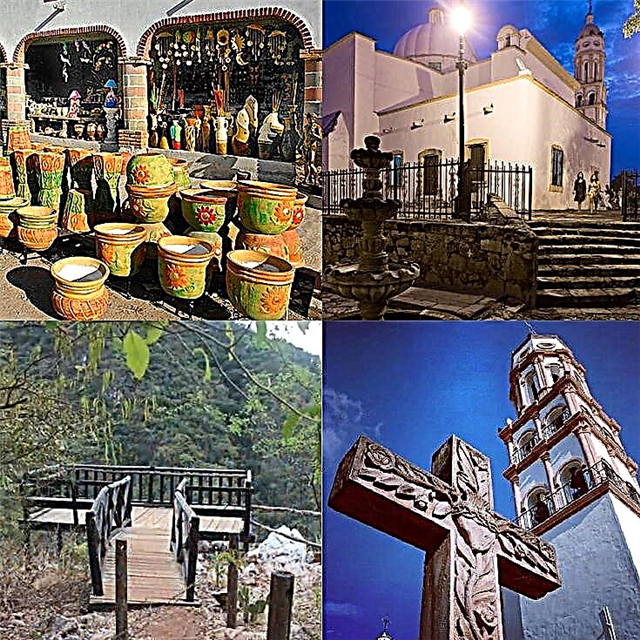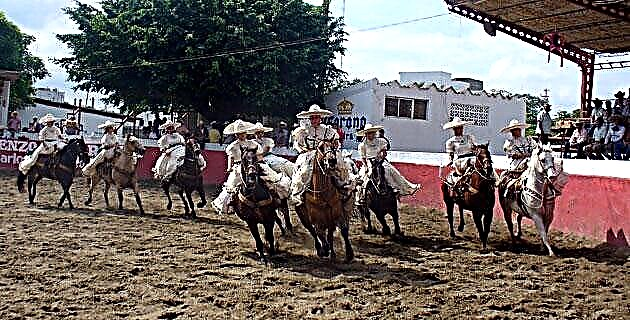
There are many species of cactus that no longer exist in Mexico; others are about to disappear.
As with various families of the Mexican flora, cacti also become extinct before scientists study them and discover their multiple qualities; many species have ceased to exist without us knowing what wealth we lost with their disappearance. In the case of cacti, this is very serious, since it is suspected that their economic potential, still little studied, is immense.
It is known, for example, that many species are rich in alkaloids. Peyote contains no less than 53 alkaloids - mescaline is but one of them. These are the results of a recent investigation by Dr. Raquel Mata and Dr. MacLaughling, who studied about 150 plants of that family. The pharmaceutical potential of this species is evident.
THE NOPAL, ENEMY OF DIABETES
Our traditional medicine makes frequent use of cacti. An example: for centuries, healers take advantage of the hypoglycemic qualities of nopal in the treatment of diabetes; However, only a very short time ago, thanks to the perseverance of the researchers of the Imss Unit for the Development of New Medicines and Traditional Medicine, this property of the nopal was scientifically accepted. Since then, Social Security has a new, harmless, cheaper and more effective drug to fight diabetes: lyophilized nopal juice, soluble powder. Another example: it is believed that some organs in our deserts are used to fight cancer; Certainly, this genus of cactus is rich in antibiotics and triterpenes.
RADIOACTIVE CACTUS?
In a completely different field, Dr. Leia Scheinvar, from the UNAM Cactology Laboratory, studies the possible use of cacti as bioindicators of metals in the subsoil. In other words, an examination of the shapes and colors of the cacti could pinpoint the precise location of metal deposits. The origin of this research is still curious. Dr. Scheinvar observed necrosis and special color changes in many cacti in the Zona del Silencio and San Luis Potosí, places that appear to be rich in uranium. Further conversations with researchers from the German Democratic Republic, particularly interested in studying bioindicator plants, put her on that track.
The economic interest of the nopal is evident: it is not limited to its use as human food (this cookbook includes no less than 70 recipes) but also as forage it is highly appreciated; We have already talked about some of its medicinal uses; It is also the base for shampoos, creams and other cosmetics; It is the host plant of the cochineal of the scarlet, an insect from which a dye is extracted that may soon know a new boom ...
All this wealth, largely unknown, is being lost. The situation becomes even more serious if we consider that Mexico is the largest center for diversification of cacti worldwide. Many of its genera only exist here, since about 1 000 different species live here (it is estimated that the entire family consists of 2 000 throughout the American continent).
THE "TOURISTS", WORSE THAN GOATS
Dr. Leia Scheinvar points out three main causes of the extinction of cacti: grazing, mainly goats, which, according to her, “should be exterminated from Mexico; other animals even help the vegetative propagation of cacti: they remove the thorns, eat a little of the pith and leave the rest of the plant intact. A new bud sprouts from that wound. The Japanese use a similar method for the propagation of globose cacti: they section the upper part and graft it, while the lower part multiplies vegetatively. Goats, on the other hand, eat the plant from the root ”.
Another important cause is agricultural practices, mainly slashing and burning of virgin lands. To lessen the effects of these two sources of destruction, Dr. Scheinvar conceived the project to create cactus reserves. She proposes that land be allocated for the conservation of cacti in strategic areas and that at the same time “a campaign be made among the peasants so that before beginning to clear their land they notify the managers of the reserves and they can go to collect the specimens. threatened ”.
The third case cited by Dr. Scheinvar is less innocent and therefore more scandalous: looting.
"Cactus looters are a real pest." The most damaging are “certain groups of tourists who come from Switzerland, Germany, Japan, California. , with a well-defined purpose: to collect cactus. These groups are led by people who bring lists of various locations and the species that they will find in each one. The group of tourists arrives at a site and takes thousands of cacti; it leaves and arrives at another site, where it repeats its operation and so on. It's a tragedy".
Manuel Rivas, a cactus collector, tells us that “not long ago they arrested a group of Japanese cactologists who had already come with maps of the areas of greatest cactological interest. They had already collected a large number of succulents in various locations around the country. They were imprisoned and the seized plants were distributed to different Mexican institutions ”. These excursions are organized in the various "cactus friends societies" common in Europe.
THE SEVENTH PLAGUE, OUR “FLOWER GROWERS”
Other looters are flower traders: they go to the areas where the cacti with the highest commercial value grow and wipe out entire populations. “On one occasion,” Dr. Scheinvar says, “we discovered near Tolimán, in Querétaro, a plant of a very rare species that was believed to be extinct in the country. Happy with our finding, we discussed it with other people. Some time later, a student of mine who lives in the region told me that a truck arrived one day and took all the plants. I made a special trip just to verify the fact and it was true: we didn't find a single specimen.
The only thing that currently preserves many species of cactus is the isolation in which large areas of the country still exist. We must recognize that this situation is also due, in large part, to our disinterest in cacti. Certain Mexican varieties cost more than $ 100 abroad; flower growers typically pay $ 10 for a batch of 10 Mexican cactus seeds. But here, perhaps because we are used to seeing them, we prefer, as Mr. Rivas says, “an African violet, because it is African, to growing a cactus”.
This disinterest is openly manifested in the comments of some visitors to Mr. Rivas's collection: “Often people who visit me are amazed at the large number of cacti they see here and they ask me why I keep so many nopales. "They are not nopales," I answered, "they are plants of many types." "Well no," they tell me, "for me they are all nopales."
MANUEL RIVAS, DEFENDER OF THE CACTUS
Mr. Manuel Rivas has more than 4,000 cacti on the roof of his house. in the San Ángel Inn neighborhood. The history of your collection. One of the most important in the country is that of a passion that has lasted for almost 20 years. Its collection is surprising not only for its quantity - it includes, for example, two-thirds of the species of the genus Mammillaria, which comprises, in total, about 300 - but for the perfect order and state in which each plant is found, up to the smallest specimen. Other collectors and scholars entrust him with the care of their specimens. In the Botanical Garden of the UNAM, Mr. Rivas spends two or three days each week looking after the shadow house of the Cactology Laboratory.
He tells us the story of his collection: “In Spain I had some cacti as rare plants. Then I came to Mexico and found them in large numbers. I bought a few. When I retired, I increased the collection and had a greenhouse built: I put more plants there and dedicated myself to planting. The first specimen in my collection was an Opuntia sp., Which was accidentally born in my garden. I still have it, more for sentimental reasons than anything else. Approximately 40 percent has been collected by me; I have bought the rest or other collectors have given it to me.
“What attracts me to cacti is their shape, the way they grow. I enjoy going to the field to look for them and to find some that I do not have. That's the thing about every collector: he's always looking for more, even if it no longer has a place. I have brought cacti from Querétaro, Zacatecas, San Luis Potosí, Veracruz, Puebla, Oaxaca… It is easier to say where not from; I have not been to Tamaulipas, or Sonora, or Baja California. I think those are the only states that I have yet to visit.
“I have looked for plants in Haiti, where I only found one species, Mammillaria prolifera, and in Peru, from where I also brought a species of Lobivia from the shores of Lake Titicaca. I have specialized in Mammillarias, because that is the most abundant genus in Mexico. I also collect from other genera, such as Coryphanta, Ferocactus, Echinocactus; almost everything except Opuntia. I hope to gather 300 different species of Mammillaria, which means almost the entire genus (the ones from Baja California will be excepted, because due to the altitude of Mexico City they are very difficult to cultivate).
“I prefer to collect seeds, because I think that the plants grown in my greenhouse are stronger than those already grown from the field. The larger the plant, the more difficult it is for it to settle elsewhere. On many occasions I collect seeds; sometimes one or two floors. I like to go out into the field just to admire them, because I only collect in the case of not having any species, because I don't have space where to put them. I keep one or two plants of each species ”.
A botanical collection as large as that of Mr. Rivas requires a lot of care: each plant must receive, for example, a certain amount of water; some come from very arid places, others from areas with higher humidity. To water them, the collector takes a whole day a week, the same time as to fertilize them, although it is done less frequently, only twice a year. Preparing the land is a whole process that begins with the search for land in the Popocatépetl volcanic zone and in the Iturbide Dam, 60 kilometers from Mexico City. The rest, including reproduction, already concerns the art of the collector.
TWO OPTIMISTIC CASES
Among the most looted plants today are Solicia pectinata and Turinicarpas lophophoroides, but let's look at two cases in which the general trend is reversed. LaMammillaria sanangelensisera very abundant in the lava fields of southern Mexico City, hence its name. Unfortunately, this plant produces a very beautiful crown of flowers in December (formerly Mammillaria elegans). The workers of a paper factory and other settlers in the area collected it to decorate their Christmas nativity scenes. Once the holidays were over, the plant was thrown away. That was one of the causes of his disappearance. The other was the Pedregal urbanization; Mammillaria sanangelensis was eradicated; However, Dr. Rublo, from the Unam Cactology Laboratory, has dedicated himself to reproducing this plant through the curious system of tissue culture, in which a few cells give rise to a new individual, with characteristics identical to those from the specimen from which the cells are extracted. There are currently more than 1,200 Mammillaria sanangelensis, which will be reintegrated into their natural environment.
Mammillaria herrera had long been sought after for its ornamental value, so much so that it was considered in danger of extinction, since it had not been found since it was described. It was known because some specimens were conserved in European greenhouses - and perhaps in a few Mexican collections - but their habitat was unknown. Dr. Meyrán, a specialist in endangered cacti and editor of the Revista Mexicana de Cactología, had been looking for it for more than five years. A group of students from UNAM found it in the spring of 1986. “The locals had told us about the plant; they called it a "ball of yarn." We identify it in the photographs. Some offered to accompany us to the place where I grew up. After two days of searching, we were about to give up when a child led us to the right place. We walked for six hours. Before we had passed very close to the place, but on the other side of the hill ”. Several specimens of this showy plant are under the care of the university Cactology Laboratory and they are expected to be reinserted soon.
Source: Unknown Mexico No. 130 / December 1987











